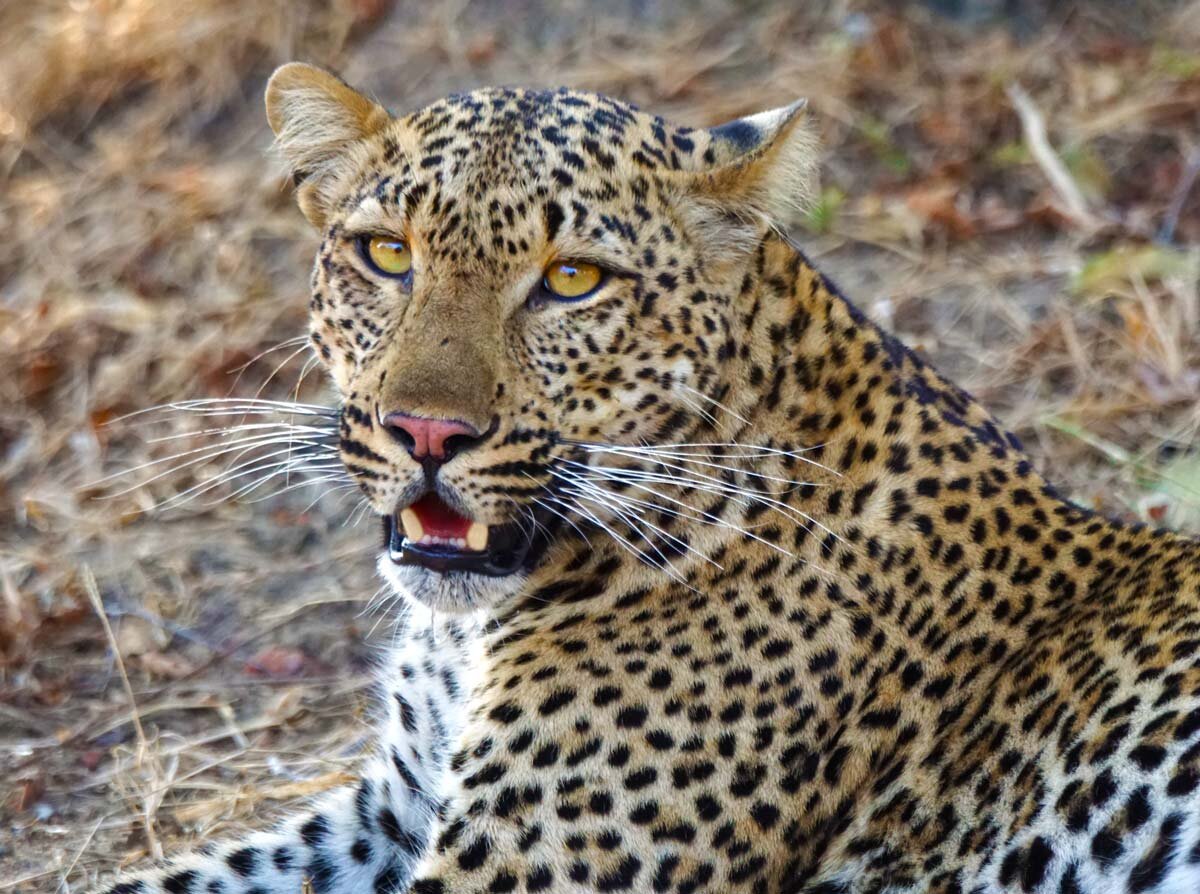Botswana - New Life in the Okavango Delta

© Image: Henry Jedelsky
Great Plains operates several camps in the northern Okavango Delta. In early December, before the start of the rainy season, Elisabeth and Henry Jedelsky visited the Duba Explorer, Sitatunga Private Island, and the easternmost Zarafa Camp.
The Ethiopian Airlines flight from Addis Ababa touches down smoothly on the runway at Maun Airport, concluding a roughly 4-hour journey from Vienna. We step into a hot, shimmering world of gray-brown bushes, patches of green, and dried-up islands connected by narrow yellow paths. A ten-seater Cessna jet takes us on a 30-minute flight to a small airstrip where a helicopter is already waiting. The cockpit is a tight squeeze, just enough room for the pilot, the two of us, and our bags. We quickly strap on our headphones and ready our cameras just in time for takeoff. Below us, the Okavango Delta unfolds — parched and dry ahead of the rainy season. Less than ten minutes later, we touch down near Duba Explorer Camp, where our safari guide, Foster, greets us with a gleaming new Toyota Land Cruiser. It’s time for High Tea, a relaxed welcome during which we’re introduced to Tent No. 3 and briefed on the camp's routine. We have the place entirely to ourselves.
No sooner have we set off on our first game drive than we spot two lionesses stalking a group of Tsessebe antelopes. But Foster has something even more extraordinary up his sleeve: in the golden afternoon light, the tall savanna grass begins to ripple and part, revealing the round black ears of an ever-growing pack of wild dogs. More of these beautifully mottled creatures appear, sniffing and exploring around our vehicle. It’s the Vumbura pack — with more than 26 members, one of the largest wild dog packs in southern Africa. Ever since lions wiped out nearly the entire resident Duba pack, leaving only two survivors, sightings of this neighboring wild dog pack have become increasingly frequent. A swarm of vibrantly colored birds called "little bee-eaters" catches our attention — we capture some great shots. But the scene is soon dominated by a brutal clash between two Red Lechwe antelopes. The bucks lock horns and battle furiously, oblivious to the world, vying for territory and the attention of the nearby females.
By sunrise the next morning, we're already out again. We trail a Nilwaran as it slinks through the brush, then catch up with the same two lionesses from the night before, capturing breathtaking shots of them bathed in the soft, golden glow of early morning. Word of two leopards reaches us, but we return to camp for lunch. After a restful break, we set off again. Zebras, giraffes, and ostriches wander across our path as we make our way through the bush, until our guide steers us toward a surprise—an open-air barbecue set up by the Duba Explorer team in the heart of the savanna. Sundowners and steaks beneath a glowing red sunset — this is Africa at its finest.
After a long, sweltering night, we pause for breakfast beside one of the region’s last surviving waterholes. A herd of massive Cape Buffalo, numbering in the thousands, crowds around this final source of water. Plumes of dust rise into the air, and the sheer thirst of so many animals is deeply moving.
The Ethiopian Airlines flight from Addis Ababa touches down smoothly on the runway at Maun Airport, concluding a roughly 4-hour journey from Vienna. We step into a hot, shimmering world of gray-brown bushes, patches of green, and dried-up islands connected by narrow yellow paths. A ten-seater Cessna jet takes us on a 30-minute flight to a small airstrip where a helicopter is already waiting. The cockpit is a tight squeeze, just enough room for the pilot, the two of us, and our bags. We quickly strap on our headphones and ready our cameras just in time for takeoff. Below us, the Okavango Delta unfolds — parched and dry ahead of the rainy season. Less than ten minutes later, we touch down near Duba Explorer Camp, where our safari guide, Foster, greets us with a gleaming new Toyota Land Cruiser. It’s time for High Tea, a relaxed welcome during which we’re introduced to Tent No. 3 and briefed on the camp's routine. We have the place entirely to ourselves.
No sooner have we set off on our first game drive than we spot two lionesses stalking a group of Tsessebe antelopes. But Foster has something even more extraordinary up his sleeve: in the golden afternoon light, the tall savanna grass begins to ripple and part, revealing the round black ears of an ever-growing pack of wild dogs. More of these beautifully mottled creatures appear, sniffing and exploring around our vehicle. It’s the Vumbura pack — with more than 26 members, one of the largest wild dog packs in southern Africa. Ever since lions wiped out nearly the entire resident Duba pack, leaving only two survivors, sightings of this neighboring wild dog pack have become increasingly frequent. A swarm of vibrantly colored birds called "little bee-eaters" catches our attention — we capture some great shots. But the scene is soon dominated by a brutal clash between two Red Lechwe antelopes. The bucks lock horns and battle furiously, oblivious to the world, vying for territory and the attention of the nearby females.
By sunrise the next morning, we're already out again. We trail a Nilwaran as it slinks through the brush, then catch up with the same two lionesses from the night before, capturing breathtaking shots of them bathed in the soft, golden glow of early morning. Word of two leopards reaches us, but we return to camp for lunch. After a restful break, we set off again. Zebras, giraffes, and ostriches wander across our path as we make our way through the bush, until our guide steers us toward a surprise—an open-air barbecue set up by the Duba Explorer team in the heart of the savanna. Sundowners and steaks beneath a glowing red sunset — this is Africa at its finest.
After a long, sweltering night, we pause for breakfast beside one of the region’s last surviving waterholes. A herd of massive Cape Buffalo, numbering in the thousands, crowds around this final source of water. Plumes of dust rise into the air, and the sheer thirst of so many animals is deeply moving.
That afternoon, it's time for goodbyes. We thank Foster, the chefs, and the dedicated staff with heartfelt tips before lifting off by helicopter toward our next destination: Sitatunga Private Island Camp.
Again, just five luxury tents and a highly attentive team of 30 staff members, each an expert in their field. The camp is nestled in a small forest inhabited by a lively troop of baboons, prompting us to fasten our tent zippers with carabiner clips for extra security. "But give it a few weeks, and they’ll have those figured out too," one staff member says knowingly.
Inside our roomy tent are soft leather armchairs and stunning black-and-white photos by Beverly Joubert, who runs 14 camps in southern Africa with her husband, Derek. The amenities also include a Canon 5D Mark IV with a telephoto lens, Leica binoculars, a stocked bar, and a desk with safari books and reading glasses — standard equipment here. We have a small plunge pool on our terrace, but I prefer the freestanding copper bathtub in the tent. In this heat, a little luxury is well deserved.
In the late afternoon, we embark on our first boat ride. Our guide, oddly named Fourtyfour, expertly handles the heavy outboard motor. We pass two lagoons near the camp, then enter a channel that opens into the slow-moving Okavango. From the air, we’d already spotted something remarkable: the thick papyrus swamps lining the river are bone-dry this time of year, often sparking into massive bushfires on their own. At times, our boat cuts through walls of whipping flames, then glides into a charred landscape of blackened stalks and smoldering stems. Smoke rises on the horizon, and it seems nothing could survive this inferno — but we are wrong. Malachite Kingfishers dart from bank to bank, and new green shoots peek from the charred roots. "In two weeks, it’ll all be green again — so thick you can’t see your hand in front of your face," says Fourtyfour. We came here exactly for this open visibility — to find the almost mythical, incredibly shy Sitatunga Antelope. Rarely photographed, it was once spoken of in hushed, superstitious tones by white hunters in East Africa.
At this time of year, many antelope species graze on the fresh greenery, and newborns are everywhere. Life returns to the riverbanks—it's a season full of magic and energy. Fourtyfour ties the boat to a clump of papyrus while I observe a baby Nile Crocodile that has been watching us motionlessly for over half an hour. Elisabeth and I stay on the boat deck while Fourtyfour leaps ashore into the still-smoldering bush—a risky move, as large crocodiles burrow tunnels beneath the papyrus, which could collapse and trap him between burning roots and a furious reptile.
Luckily, that doesn’t happen, but we do catch fleeting glimpses of the startled Sitatungas as they dart off. We continue on, encountering a group of agitated hippos, a few giant crocodiles diving beneath the surface, and elephants grazing on the last patches of papyrus. We encounter African Fish Eagles, Darters, and even a Puff Adder slithers its way across the water. We return home to the warm glow of kerosene lamps, welcoming us long before we arrive. After a superb dinner—beef, Botswana’s national dish—and a few perfectly mixed sundowners, we make our way to our tent, all while being watched by a colony of epauletted fruit bats nesting high in the trees between the main tent and a towering baobab.
Again, just five luxury tents and a highly attentive team of 30 staff members, each an expert in their field. The camp is nestled in a small forest inhabited by a lively troop of baboons, prompting us to fasten our tent zippers with carabiner clips for extra security. "But give it a few weeks, and they’ll have those figured out too," one staff member says knowingly.
Inside our roomy tent are soft leather armchairs and stunning black-and-white photos by Beverly Joubert, who runs 14 camps in southern Africa with her husband, Derek. The amenities also include a Canon 5D Mark IV with a telephoto lens, Leica binoculars, a stocked bar, and a desk with safari books and reading glasses — standard equipment here. We have a small plunge pool on our terrace, but I prefer the freestanding copper bathtub in the tent. In this heat, a little luxury is well deserved.
In the late afternoon, we embark on our first boat ride. Our guide, oddly named Fourtyfour, expertly handles the heavy outboard motor. We pass two lagoons near the camp, then enter a channel that opens into the slow-moving Okavango. From the air, we’d already spotted something remarkable: the thick papyrus swamps lining the river are bone-dry this time of year, often sparking into massive bushfires on their own. At times, our boat cuts through walls of whipping flames, then glides into a charred landscape of blackened stalks and smoldering stems. Smoke rises on the horizon, and it seems nothing could survive this inferno — but we are wrong. Malachite Kingfishers dart from bank to bank, and new green shoots peek from the charred roots. "In two weeks, it’ll all be green again — so thick you can’t see your hand in front of your face," says Fourtyfour. We came here exactly for this open visibility — to find the almost mythical, incredibly shy Sitatunga Antelope. Rarely photographed, it was once spoken of in hushed, superstitious tones by white hunters in East Africa.
At this time of year, many antelope species graze on the fresh greenery, and newborns are everywhere. Life returns to the riverbanks—it's a season full of magic and energy. Fourtyfour ties the boat to a clump of papyrus while I observe a baby Nile Crocodile that has been watching us motionlessly for over half an hour. Elisabeth and I stay on the boat deck while Fourtyfour leaps ashore into the still-smoldering bush—a risky move, as large crocodiles burrow tunnels beneath the papyrus, which could collapse and trap him between burning roots and a furious reptile.
Luckily, that doesn’t happen, but we do catch fleeting glimpses of the startled Sitatungas as they dart off. We continue on, encountering a group of agitated hippos, a few giant crocodiles diving beneath the surface, and elephants grazing on the last patches of papyrus. We encounter African Fish Eagles, Darters, and even a Puff Adder slithers its way across the water. We return home to the warm glow of kerosene lamps, welcoming us long before we arrive. After a superb dinner—beef, Botswana’s national dish—and a few perfectly mixed sundowners, we make our way to our tent, all while being watched by a colony of epauletted fruit bats nesting high in the trees between the main tent and a towering baobab.
The next day, the helicopter takes us back to the airstrip, where we catch our Mack Air flight eastward to Zarafa Camp, perched on the nearly dry Savuti River, just before the Savuti Marshes. Here too, life gathers around the waterholes: herds of elephants with clumsy, well-guarded calves, majestic giraffes, graceful impalas, stocky warthogs, and groups of zebras. The plain before the camp pulses with life. A small lion pride, led by an experienced lioness, hopes for an easy kill but finds itself in the territory of a much larger, stronger pride.
Our guide here is Rasta, who skillfully steers his Land Cruiser, complete with phone chargers, through dry island patches and scattered groves, where we suspect a pair of love-struck leopards might be hiding. We follow the tracks of a large male through the bush, and along the way, Rasta and I find a broken elephant tusk weighing over ten kilos. We leave it for the Great Plains rangers, who are trained and paid by the company. Later, we spot the female leopard resting in the fork of a tree. We capture more stunning shots of the beautiful, spotted female, but her majestic mate leaves behind only his massive paw prints.
For today, it’s “Let’s call it a day.” We arrive back at Zarafa Camp to a warm welcome of Botswanan songs, where the team has lit a crackling campfire and set a spectacular dinner beneath the starlit Kalahari sky, all under the sweeping branches of a giant baobab tree. We recount the events of the past days, as brilliant white lightning flashes on the horizon. In a few days — maybe even hours — southern Africa's rainy season will begin in full force, filling ponds, trickles, and rivers, and finally extinguishing the last of the papyrus fires in the Okavango. And so, just as it has for thousands of years, life in this river delta at the heart of the Kalahari will once again erupt in full, breathtaking splendor.
Author: Henry Jedelsky
Our guide here is Rasta, who skillfully steers his Land Cruiser, complete with phone chargers, through dry island patches and scattered groves, where we suspect a pair of love-struck leopards might be hiding. We follow the tracks of a large male through the bush, and along the way, Rasta and I find a broken elephant tusk weighing over ten kilos. We leave it for the Great Plains rangers, who are trained and paid by the company. Later, we spot the female leopard resting in the fork of a tree. We capture more stunning shots of the beautiful, spotted female, but her majestic mate leaves behind only his massive paw prints.
For today, it’s “Let’s call it a day.” We arrive back at Zarafa Camp to a warm welcome of Botswanan songs, where the team has lit a crackling campfire and set a spectacular dinner beneath the starlit Kalahari sky, all under the sweeping branches of a giant baobab tree. We recount the events of the past days, as brilliant white lightning flashes on the horizon. In a few days — maybe even hours — southern Africa's rainy season will begin in full force, filling ponds, trickles, and rivers, and finally extinguishing the last of the papyrus fires in the Okavango. And so, just as it has for thousands of years, life in this river delta at the heart of the Kalahari will once again erupt in full, breathtaking splendor.
Author: Henry Jedelsky
About Great Planes Conservation
Dereck and Beverly Joubert aren’t just the founders of Great Plains Conservation; they’re a legendary explorer duo who’ve spent over 40 years capturing Africa’s wild soul on film. With eight Emmys, a deep love for big cats, and a serious commitment to protecting what’s left of the wilderness, their passion flows into every one of their luxury safari camps. From Botswana to Kenya, they now invite you to step into their world, where conservation meets adventure and every sunrise tells a story.





















































